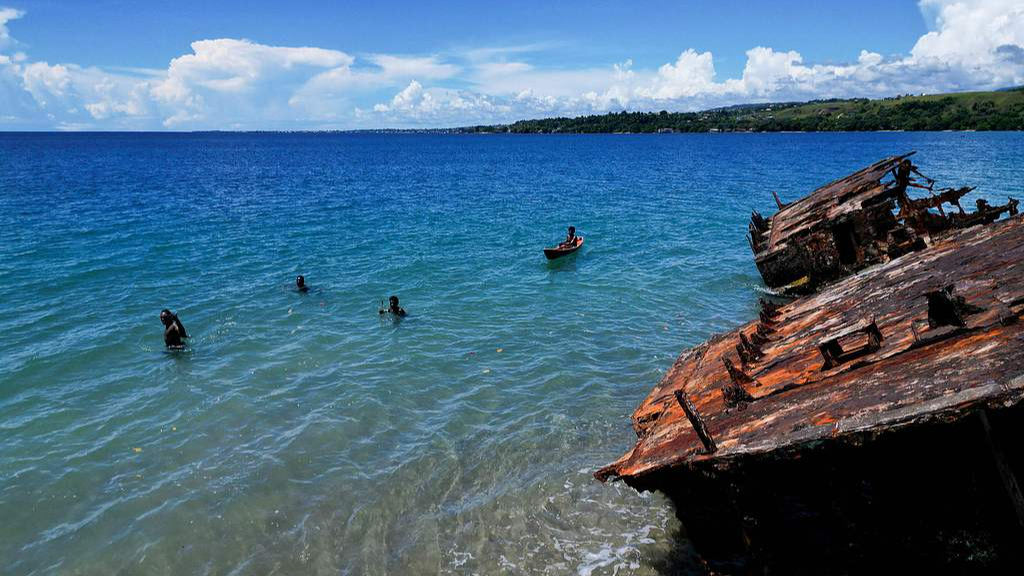Villagers are seen next to a washed up shipwreck on the outskirts of Honiara, capital of the Solomon Islands, April 21, 2024. /VCG
Pacific Island nations are among the world’s most affected by marine plastic pollution – despite contributing little to the problem themselves.
Plastic debris, carried by powerful ocean currents, has been washing ashore on the coasts of these islands in increasing volumes, threatening fragile ecosystems, local fisheries and public health. Governments, international organizations and scientists – including Chinese researchers – are now working together to address the crisis at its source.
Remote nations, global problem
Although most plastic waste is produced in industrialized countries, powerful currents in the Pacific Ocean transport large volumes of it to the South Pacific, making remote island nations the unintended recipients of a global pollution crisis. According to the United Nations Environment Programme, more than 11 million tonnes of plastic enter the ocean each year – a figure projected to nearly triple by 2040 without urgent intervention – per its report in 2021. Much of this waste accumulates in large marine debris zones, such as the Great Pacific Garbage Patch, before dispersing toward smaller island ecosystems.
Experts say the problem is compounded by a mix of legacy and current sources. According to Professor Li Daoji, director of the Marine Plastic Debris and Microplastics Regional Training and Research Centre at UNESCO-IOC, plastic waste in the Pacific has accumulated over decades, particularly from developed countries. Events such as the 2011 tsunami following the Fukushima earthquake in Japan also contributed significantly, sweeping vast quantities of plastic debris into the ocean.
A 2022 study published in Scientific Reports, a peer-reviewed journal under the Nature portfolio, revealed that fishing gear, including buoys and nets, accounts for a large share of plastic debris in the North Pacific. As noted by National Geographic, it is difficult to estimate the total volume of plastic due to the massive scale of the North Pacific Subtropical Gyre and the fact that not all plastic remains afloat – denser materials may drift several meters below the surface, complicating cleanup efforts.
The impact
For countries such as Fiji, Vanuatu and Samoa, clean oceans are central to food security, livelihoods and tourism. Plastic waste affects fish stocks, damages coral reefs and can introduce toxins into the food chain. Local communities are increasingly concerned about the potential health impacts of microplastics found in seafood and drinking water.
“We need to stop treating our ocean like a dumping ground,” said Victor Bonito at the Pacific Islands Conference on Ocean Science and Ocean Management in September 2023.
Global governance and China’s role in collaborative effort
As global momentum builds to combat plastic pollution, countries are beginning to align on comprehensive solutions. In March 2022, the United Nations Environment Assembly adopted a landmark resolution titled “End Plastic Pollution: Towards an International Legally Binding Instrument.” The resolution mandates the creation of an intergovernmental negotiating committee to draft a legally binding agreement on plastic pollution by the end of 2024, covering the full life cycle of plastics – from design to disposal.
In the meantime, countries like China have been actively working on domestic policies to address plastic pollution. For instance, China’s “14th Five-Year Plan” includes a comprehensive strategy for plastic pollution control, focusing on reducing plastic production and improving waste management.
Additionally, China has been collaborating with Pacific Island nations to enhance their capacities in marine environmental protection and sustainable fisheries development.
According to Wang Xiaohu, director of the Chinese Academy of Fishery Sciences, the academy has hosted training programs focused on aquaculture and seafood processing for Pacific Island partners. “This year (2023), we plan to hold seven fisheries training programs tailored for Pacific Island countries,” Wang said, adding that China is working to translate research outcomes into local applications through technical exchanges and joint innovation.
Academic cooperation is also growing. According to Wan Rong, president of the Shanghai Ocean University, the university has maintained a partnership with Fiji for over two decades. In 2023, students from Tonga, Vanuatu, Kiribati and Samoa came to study marine and biological sciences at our campus.
“We will continue to welcome young talent from the Pacific and provide opportunities for mutual learning,” said Wan.


